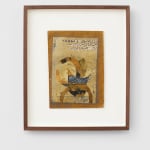Huda LUTFI Egyptian, b. 1948
Untitled (Healing Devices), 2019
Mixed media on paper
18 x 13.5 cm | 7 x 5 1/2 in
Framed: 29.5 x 24 x 4 cm | 11 1/2 x 9 1/2 x 1 1/2 in
Framed: 29.5 x 24 x 4 cm | 11 1/2 x 9 1/2 x 1 1/2 in
Huda LUTFI (b. 1948) a cultural, gender historian by professional training whose work in the field of the visual arts translates these affiliations in multiple complex ways. In 1983, she...
Huda LUTFI (b. 1948) a cultural, gender historian by professional training whose work in the field of the visual arts translates these affiliations in multiple complex ways. In 1983, she received her PhD in Arab Muslim Cultural History from McGill University, Montreal, Canada. A self-trained artist, Lutfi, began her practice during the mid-1990s, amid the rise of an independent art scene and the establishment of a number of influential art institutions.
Inspired by the mechanical designs of Ismail al- Jazari, a 12th-century Arab engineer and craftsman, this series of paper works explores forgotten zones of historical memory. Huda Lutfi first encountered al-Jazari’s 'The Knowledge of Ingenious Mechanical Devices' while researching medieval medical manuscripts for an installation in Cairo’s historic Qalawun hospital in 2019. Containing about a hundred detailed inventions, al-Jazari’s book reveals a deep cultural heritage of engineering and design that may reach back to the Hellenistic era. Although it is unclear whether his devices were ever realized, al-Jazari’s writings offer a rich archive of ideas for art, design, and mechanical creation— from self-operating clocks and water wheels to pitchers and fountains. The artist was particularly drawn to his belief in invention as a path to ease and productivity. Building on this spirit, the series reimagines al- Jazari’s devices as “imaginary healing machines,” accompanied by indecipherable textual formulas that allude to inner repair and emotional resilience amid constraint. Rendered as painted paper collages, the works emphasize sculptural form and layered surfaces that evoke palimpsests—traces of knowledge resurfacing through time. Hints of silver and gold recall illuminated manuscripts, suggesting that ancient ingenuity continues to inspire contemporary healing and creativity.
Selected solo exhibitions include 'Unraveling' (2025), The Third Line, Dubai; 'Healing Devices', Dallas Museum of Art, Texas (2021); 'Our Black Thread' Gypsum Gallery, Cairo, Egypt (2021); 'When Dreams Call for Silence', The American University in Cairo, Tahrir Cultural Center, Cairo, Egypt (2019); 'Still', The Third Line, Dubai, UAE (2018); 'Magnetic Bodies: Imaging the Urban', The Third Line, Dubai, UAE (2016) to name a few. Her work is part of major collections including: Los Angeles County Museum of Art (LACMA), Los Angeles; Barjeel Art Foundation, Sharjah, UAE; Jordan National Gallery of Fine Arts, Amman, Jordan; Circustheater Foundation, Hague, Netherlands; The American University in Cairo; The British Museum, London, UK; The World Bank, Egypt. Muscarelle Museum of Art, Virginia, USA; Indianapolis Museum, Indianapolis; Margueitte Hoffman Art Collection, Texas.
Inspired by the mechanical designs of Ismail al- Jazari, a 12th-century Arab engineer and craftsman, this series of paper works explores forgotten zones of historical memory. Huda Lutfi first encountered al-Jazari’s 'The Knowledge of Ingenious Mechanical Devices' while researching medieval medical manuscripts for an installation in Cairo’s historic Qalawun hospital in 2019. Containing about a hundred detailed inventions, al-Jazari’s book reveals a deep cultural heritage of engineering and design that may reach back to the Hellenistic era. Although it is unclear whether his devices were ever realized, al-Jazari’s writings offer a rich archive of ideas for art, design, and mechanical creation— from self-operating clocks and water wheels to pitchers and fountains. The artist was particularly drawn to his belief in invention as a path to ease and productivity. Building on this spirit, the series reimagines al- Jazari’s devices as “imaginary healing machines,” accompanied by indecipherable textual formulas that allude to inner repair and emotional resilience amid constraint. Rendered as painted paper collages, the works emphasize sculptural form and layered surfaces that evoke palimpsests—traces of knowledge resurfacing through time. Hints of silver and gold recall illuminated manuscripts, suggesting that ancient ingenuity continues to inspire contemporary healing and creativity.
Selected solo exhibitions include 'Unraveling' (2025), The Third Line, Dubai; 'Healing Devices', Dallas Museum of Art, Texas (2021); 'Our Black Thread' Gypsum Gallery, Cairo, Egypt (2021); 'When Dreams Call for Silence', The American University in Cairo, Tahrir Cultural Center, Cairo, Egypt (2019); 'Still', The Third Line, Dubai, UAE (2018); 'Magnetic Bodies: Imaging the Urban', The Third Line, Dubai, UAE (2016) to name a few. Her work is part of major collections including: Los Angeles County Museum of Art (LACMA), Los Angeles; Barjeel Art Foundation, Sharjah, UAE; Jordan National Gallery of Fine Arts, Amman, Jordan; Circustheater Foundation, Hague, Netherlands; The American University in Cairo; The British Museum, London, UK; The World Bank, Egypt. Muscarelle Museum of Art, Virginia, USA; Indianapolis Museum, Indianapolis; Margueitte Hoffman Art Collection, Texas.
Join our mailing list
* denotes required fields
We will process the personal data you have supplied to communicate with you in accordance with our Privacy Policy. You can unsubscribe or change your preferences at any time by clicking the link in our emails.



